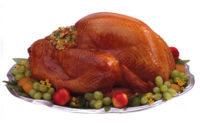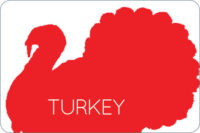The turkey market downturn that began in 2012 continued into this year. While prices for some parts recovered during the year, prices for breast meat — and to some extent whole turkeys — continued to be soft throughout the year. An improved feed-cost outlook mitigated some of the pain from low prices, but the feed markets remain extremely volatile because of the federal renewable fuels policy, and most processors found their margins squeezed.
There is reason for cautious optimism heading into 2014. Most processors appear to have cut production, and USDA in mid-September announced a 30-million-pound bonus purchase of breast meat and whole birds. These actions increased hope that cold-storage stocks, which remained high at the end of summer, would begin to return to more normal levels.
Additionally, the industry had reason to be optimistic that initiatives in Washington might lead to increased economic and regulatory stability.
Renewable Fuels Policy
The National Turkey Federation (NTF) made reform or repeal of the Renewable Fuels Standard (RFS) a top priority since before the standard was officially enacted in 2005 (and extended in 2007). As NTF members predicted as early as 2003, the RFS would create incredible volatility in the feed markets, driving the price of corn to record highs in 2008 and 2012, and distorting the normal corn/soybeans plantings of farmers. It also had a devastating effect on the meat and poultry industry.
In the last year, eight turkey and chicken companies have filed for bankruptcy, closed plants, had to lay off workers or ceased a significant portion of their operations.
When EPA, ignoring advice from Congress and multiple state governors, refused to grant a waiver to the RFS in the face of last year’s crippling drought, the pendulum in Congress began to swing decidedly in favor of reform. There have been multiple hearings in Congress this year about the problems caused by the RFS, and it is increasingly likely that the House Energy and Commerce Committee will pass some type of bipartisan RFS reform bill this year.
How much further reform legislation can go in 2013 remains uncertain, but NTF is working with other meat and poultry trade groups as well as environmental organizations, anti-hunger groups, anti-tax groups and energy-related trade associations to press for final passage of a reform bill before the 2014 elections. The ethanol lobby remains a powerful force in Washington, so passage is far from assured, but the momentum definitely is shifting.
Immigration
There is currently no one bill that is a “silver bullet,” but for companies to ensure the legal hiring of enough qualified workers, using a trusted E-Verify program is essential and critical to the long-term success of the U.S. economy.
The turkey industry employs more than 100,000 workers, who produce more than $10 billion worth of turkey products at more than 60 plants across the country. Employers tasked with hiring must have a reliable means to confirm that new hires are legally authorized to work in the United States — and because of identity theft, must be assured that when employers use the verification system in good faith, they are removed from legal liability.
Access to labor is important beyond just that of the seasonal agricultural industry. An expanded visa program for full-time, lower-skilled workers should address the needs of the entire business community. Clear, specified requirements for earned legalization for year-round employment needs are more realistic in the poultry business for the investment in training, cost of overseas relocation and search for housing.
Exports
Turkey maintained strong exports in 2013. According to USDA, turkey product shipments have been steady throughout the first half of 2013 with exports totaling 358 million pounds. The top three export markets for U.S. turkey meat were Mexico, Hong Kong and China.
Interestingly, other export markets grew even faster in the first half of the year than Mexico, but at 193 million pounds, Mexico still accounted for 54 percent of the total.
Boneless dark meat remains the top turkey product being exported.
The entire market picture, domestic and export, could change by the end of 2013 — if USDA is correct in forecasting a decline in all livestock and poultry production.
Production
The latest USDA forecast for U.S. turkey meat production is expected to be lower in the second half of 2013. As noted, tighter stocks and lower prices have caused turkey producers to reduce poult placements well below the previous year. This is again related to the RFS, the 2012 drought, the sluggish pace of economic recovery and the increased prices that come with the higher cost of corn.
Though poult placements were down 5 percent or more through most of 2013, average bird weights continue to increase. Turkey meat production during the first six months of 2012 was 2.9 billion pounds, down fractionally (0.2 percent) from the same period in 2012. The forecast for turkey meat production in the second half of 2013 was reduced by 20 million pounds to 3.0 billion, a decline of 2.1 percent from the same period in the previous year (National Turkey Federation Sourcebook - September 2013). The turkey industry is working hard to work effectively within these new economic realities.
New Poultry Inspection System
Officials at USDA’s Food Safety and Inspection Service (FSIS) remain optimistic that they will finalize the New Poultry Inspection System regulation sometime this fall. The regulation represents the next step in modernizing the nation’s poultry inspection system in that it allows federal inspectors to devote more time to monitoring the processes that reduce the incidence of foodborne pathogens. More than a decade of results from 25 pilot plants across the nation indicate the new system would result in products that are as safe as or safer than those produced in existing plants.
Unfortunately, some labor organizations and activist groups are opposing this science-based regulation, and their complaints have gotten some traction in the media. USDA’s support for the regulation has not wavered, and NTF has worked to help foster better public understanding of the proposed rule.
Antibiotic resistance
Activist organizations also have been attacking the on-farm use of antibiotics, especially those that result in production efficiencies. Despite the fact that most production antibiotics have limited or no use in human medicine, critics charge that this on-farm use contributes to antibiotic resistance in human medicine.
In April, several organizations — including Consumers Union (publisher of Consumer Reports) attacked on-farm antibiotics use, with an article targeting ground turkey specifically. NTF has been aggressive in countering these charges.
Meantime, FDA is nearing publication of a guidance document that will seek to have drug companies voluntarily drop production claims from their labels and substitute them with specific therapeutic claims. The goal is to preserve all or most of the antibiotics used in production agriculture while potentially altering their conditions of use. NTF has been cautiously supportive of this process.
Other technical and regulatory
Through NTF, the turkey industry has remained proactive in addressing food safety, and working with FSIS to find solutions to these challenges, with an increasing focus not just on Salmonella but also Campylobacter. NTF members continue to implement aggressive pathogen-reduction activities, including the reassessment of HACCP plans, months ahead of the FSIS Notice on HACCP Plan Reassessment of Not Ready To Eat Comminuted Poultry Products. NTF worked with FSIS to shape the new testing procedures for comminuted poultry products, including MST, while helping both the agency and members identify the challenges and concerns inherent in the new, larger sample size of 325 grams for comminuted product.
The industry has worked with FSIS on many additional efforts, from domestic implementation of the Public Health Information System (PHIS) and the new Label Submission and Approval System (LSAS), to support for modernizing the entire poultry inspection system and maintaining uninterrupted meat and poultry inspection in the face of government fiscal uncertainty.
The turkey industry also continues reviewing progress in reducing Salmonella in live birds. This includes seeking out and encouraging research into how to better understand if more can be done to lower Salmonella levels on farms, while still recognizing that the plant is still the best location to implement interventions that enhance public health.
Turkey companies continue to search for additional interventions, including high-pressure pasteurization (HPP), as well as to refine their current systems, to further decrease the presence of Salmonella in ground products.
Communicating and marketing
For 2013, NTF focused on redeveloping its communications program to match the NTF 2013-2017 Strategic Plan for comprehensive communicating and marketing. NTF now has unveiled the two most visible symbols of the program’s evolution to meet the expectations and needs of consumers, reporters and NTF members: the new weekly, members-only e-newsletter, Turkey Today & Tomorrow, and the re-designed Web site, www.EatTurkey.com.
Keeping a healthy marketing and product promotion component, EatTurkey.com also now includes issues relevant to turkey growers and processors — the RFS, immigration, the Farm Bill — beyond those issues previously found in the members-only section. Bringing these stories out onto the main Web site educates the general public about how challenges and costs by growers and processors can impact families as they stretch their own food dollars.
Each week, EatTurkey.com adjusts topics of interest to the changing landscape of the animal agriculture industry — from planning a weeknight meal of turkey, to how turkeys are raised.
We satisfy their hunt for a tasty recipe, as well as their curiosity for where their food comes from, who made it, how to prepare it, and why it is a good value at the grocery store. Both consumers and NTF members are interested in the same things: providing families with healthy, nutritious and affordable food. What could be better than turkey, the perfect protein?
NTF’s daily engagement in social media offers members and consumers insight about turkey’s wide variety of healthful and delicious offerings, the cutting edge on developments and some additional food for thought shared from our members’ regular postings.









